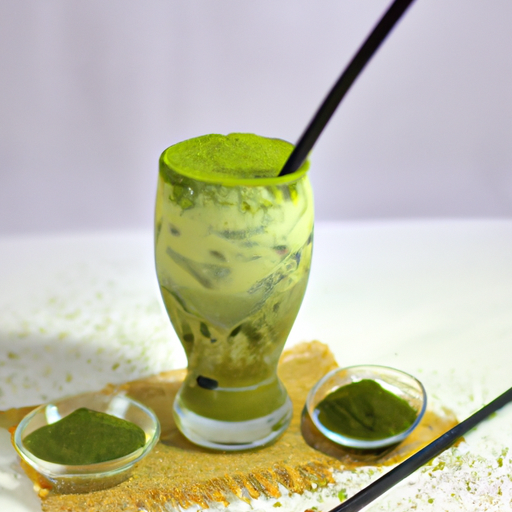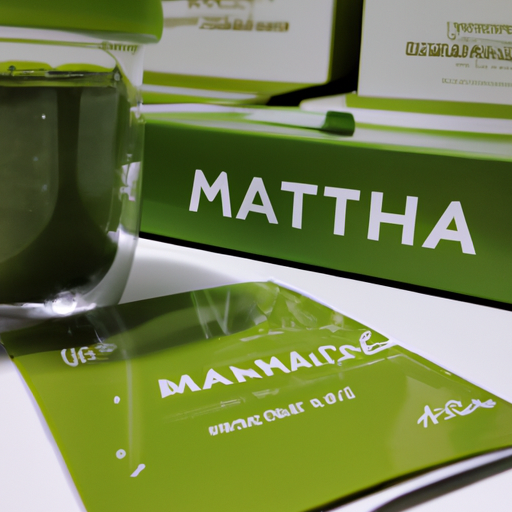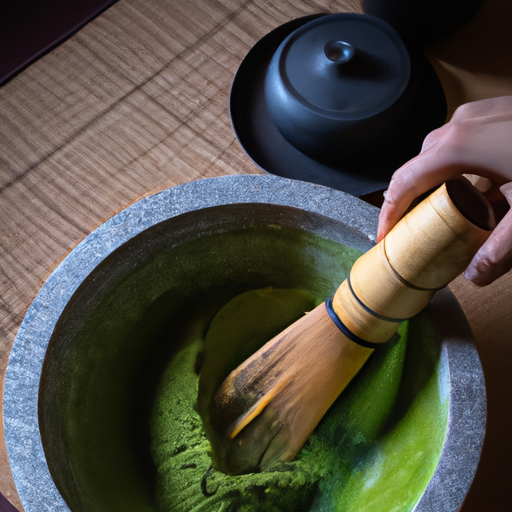I’ve always had an interest in matcha lattes, yet I wasn’t quite sure about their flavor. Therefore, I chose to explore the realm of matcha to discover the actual taste of this well-liked drink. Being a fan of both coffee and tea, the prospect of sampling something both distinct and novel intrigued me.
The first thing that struck me about matcha lattes is their vibrant green color. It’s hard not to be intrigued by their appearance.
As I took my first sip, I was pleasantly surprised. The taste was earthy and slightly bitter, but also had a hint of sweetness. I could taste the grassy notes of the matcha powder, which gave the drink a unique and complex flavor.
Overall, I found the taste of a matcha latte to be refreshing and invigorating, and definitely worth exploring further.
Key Takeaways
- Matcha lattes have a vibrant green color and earthy, slightly bitter taste with a hint of sweetness.
- Matcha powder is made from shade-grown green tea leaves ground into a fine powder and can be used in a variety of recipes.
- Matcha lattes are a healthy alternative to traditional coffee drinks, rich in antioxidants and nutrients, and can aid in weight loss and provide sustained energy without jitters or crash.
- Matcha lattes are available at local cafes, chain coffee shops, and online retailers, each with their own unique twists and flavor profiles.
What is a Matcha Latte?
You’re going to love the creamy, earthy taste of a matcha latte, made with a blend of frothy milk and finely ground green tea leaves. The matcha latte has become increasingly popular in recent years, and for good reason. It’s a delicious and healthy alternative to traditional coffee drinks, with a unique flavor that’s hard to resist.
To make a matcha latte, you’ll need a few simple ingredients: matcha powder, milk, and a sweetener of your choice (optional). The matcha powder is made from shade-grown green tea leaves that are ground into a fine powder. This process helps to preserve the natural nutrients and antioxidants found in the tea leaves.
To prepare a matcha latte, you’ll first need to whisk the matcha powder with a small amount of hot water to create a smooth paste. Then, you’ll heat up your milk (or milk substitute) and froth it until it’s nice and creamy. Finally, you’ll pour the frothy milk over the matcha paste and stir until well combined.
If you like your latte sweet, you can add a bit of honey, maple syrup, or agave nectar to taste.
The origins of matcha powder can be traced back to ancient China and Japan, where it was used in traditional tea ceremonies as a symbol of hospitality and respect. Today, matcha is enjoyed by people all over the world as a delicious and healthy beverage that’s perfect for any time of day.
The Origins of Matcha Powder
The origins of matcha powder can be traced back to the Tang Dynasty in China. It was first used for medicinal purposes and then later evolved into a popular beverage among Buddhist monks. Matcha powder was introduced to Japan by Buddhist monk Eisai in the 12th century, who brought it along with Zen Buddhism. Japanese tea culture then adopted matcha powder and transformed it into a ceremonial preparation, which has been an integral part of Japanese culture ever since.
In Japan, matcha powder is produced by shading the tea plants for several weeks before harvest, which causes an increase in chlorophyll content and gives the tea leaves a deeper green color. After harvesting, the leaves are steamed, dried, and then ground into a fine powder using traditional stone mills. This process takes an hour to produce just 30 grams of high-quality matcha powder.
As a result, consuming matcha is not only a beverage but also an experience that involves a deep appreciation for the craftsmanship and dedication required to create it.
Matcha is more than just a beverage; it’s an art form that reflects the beauty of Japanese culture. Its unique taste profile and preparation have made it a cultural icon that has spread around the world.
In the next section, we will explore the unique taste profile of matcha and why it’s become a popular beverage worldwide.
The Unique Taste Profile of Matcha
Get ready for a flavor explosion as we explore the unique taste profile of matcha powder! Matcha is known for its distinct flavor profile that sets it apart from other teas.
Here are some taste notes that make matcha so unique:
-
Umami – Matcha has a savory, almost meaty flavor that comes from the amino acid L-theanine. This flavor note is what makes matcha so satisfying and perfect for pairing with sweet treats.
-
Bitterness – Matcha can have a slightly bitter taste due to the high concentration of catechins, which are powerful antioxidants. However, this bitterness is balanced out by the sweetness of the umami flavor.
-
Vegetal – Matcha has a grassy, vegetal taste that is reminiscent of fresh greens. This taste note is what gives matcha its natural and earthy flavor profile.
-
Creamy – When prepared as a latte, matcha takes on a creamy and smooth texture that adds another layer of flavor to the drink.
Overall, matcha’s flavor profile is complex and unique, with notes of umami, bitterness, vegetal, and creamy flavors.
When drinking a matcha latte, you can expect to taste the creamy texture of the milk alongside the distinct matcha flavor. The combination of these flavors is what makes matcha lattes so popular and delicious.
What to Expect When Drinking a Matcha Latte
I absolutely love the creamy and frothy texture of a well-made matcha latte. It’s like drinking a rich and indulgent dessert, but without any of the guilt.
The balanced flavors of the matcha and milk blend perfectly, creating a delicious and satisfying drink that never fails to perk me up with its energizing effects.
Creamy and Frothy Texture
Can’t you just imagine how velvety smooth and frothy the texture of a matcha latte is? It’s like a warm hug in a cup! The creamy and frothy texture is one of the reasons why matcha latte has become a popular alternative to other creamy latte alternatives. The frothing technique used to create the thick layer of foam on top of the matcha latte is what gives it that creamy, velvety texture.
To give you an idea of just how frothy and creamy a matcha latte can be, here’s a table to paint a picture for you:
| Type of milk | Texture |
|---|---|
| Whole milk | Creamy |
| Almond milk | Nutty |
| Coconut milk | Smooth |
| Oat milk | Velvety |
The combination of the frothed milk and the finely ground matcha powder creates a drink that is not only visually appealing but also delicious. The frothy texture adds a layer of richness that balances out the slightly bitter taste of the matcha powder. Speaking of taste, let’s move on to the next subtopic about the balanced flavors of a matcha latte.
Balanced Flavors
The balanced flavors of a matcha latte are a combination of sweet and earthy notes that come together in perfect harmony. The flavor balance is what makes a matcha latte such a unique and enjoyable drink. Here are three reasons why I think the taste complexity of a matcha latte is worth trying:
-
The sweetness in a matcha latte isn’t overpowering, but rather subtle and pleasant. The natural sweetness of the matcha tea is enhanced by the addition of milk and a bit of honey or sugar. It’s not so sweet that you feel like you’re drinking a dessert, but just the right amount to complement the earthy matcha flavor.
-
The earthiness of matcha is what gives it its distinct flavor, and in a latte, it’s not lost. Instead, it’s balanced out by the sweetness and creaminess of the milk. This creates a unique taste that is both refreshing and satisfying.
-
The flavor complexity of a matcha latte is not like anything else I’ve tasted. It’s hard to describe, but it’s a combination of sweet, bitter, and earthy notes that all work together to create a harmonious taste experience.
Overall, the balanced flavors of a matcha latte make it a delicious and unique drink. But not only that, it also has energizing effects that make it a great choice for starting your day.
Energizing Effects
Get ready to feel energized with a matcha latte, perfect for a morning pick-me-up! The energizing effects of matcha are due to its high caffeine content and the presence of L-theanine, an amino acid that promotes relaxation and improved focus. Unlike coffee, matcha provides a sustained energy boost without the jitters or crash, making it an excellent choice for those who need to stay focused and alert throughout the day.
In addition to its energy-boosting properties, matcha also has the potential to increase metabolism and aid in weight loss. Studies have shown that the catechins in matcha can increase thermogenesis, which is the body’s process of burning calories to produce heat. This means that drinking matcha may help to speed up metabolism and burn more calories, making it a great choice for those looking to lose weight or maintain a healthy weight.
As you can see, matcha has many health benefits beyond just its delicious taste. So, let’s dive into the next section and learn more about the health benefits of matcha powder.
Health Benefits of Matcha Powder
You’ll feel like a superhero after sipping on a matcha latte, as the antioxidants and nutrients in the matcha powder work their magic in your body, akin to a superhero’s powers.
Matcha powder is made from ground green tea leaves that are rich in catechins, a type of antioxidant that helps protect the body from damage caused by free radicals. Additionally, matcha powder contains L-theanine, an amino acid that helps improve brain function and reduce stress.
-
Matcha powder can help boost your metabolism and aid in weight loss. The catechins in matcha powder help increase the body’s calorie-burning rate, making it easier to shed unwanted pounds. Studies have also shown that matcha powder can help reduce the amount of fat stored in the body.
-
Matcha powder can also help improve heart health. Regular consumption of matcha powder has been linked to lower levels of cholesterol and blood pressure, both of which are risk factors for heart disease. The antioxidants in matcha powder also help protect the heart from damage caused by free radicals.
-
Matcha powder can help boost your immune system. The antioxidants and nutrients in matcha powder help strengthen the body’s natural defenses against illness and disease. Additionally, matcha powder contains compounds that have been shown to have antibacterial and antiviral properties.
If you’re looking to reap the health benefits of matcha powder, there are many ways to incorporate it into your diet. From matcha recipes like smoothies and baked goods to simply adding it to hot water for a quick and easy drink, there are endless possibilities. But if you’re wanting to indulge in the creamy goodness of a matcha latte, keep reading to find out how to make one at home.
How to Make a Matcha Latte at Home
For a cozy afternoon treat, imagine yourself curled up on the couch with a warm, frothy matcha latte in hand. Not only is it delicious, but it also comes with numerous health benefits. Making a matcha latte at home is easy, and with a few tips, you can enjoy this delicious drink whenever you want.
To make a matcha latte at home, you will need just a few ingredients: matcha powder, milk, water, and sweetener if desired. Start by sifting the matcha powder into a cup or bowl to avoid clumps. Then, add hot water and whisk until it becomes a smooth paste. Next, heat up your milk and pour it into the cup with the matcha paste. Finally, sweeten to taste and enjoy.
One of the biggest benefits of making a matcha latte at home is that you can customize it to your liking. For example, you can experiment with different types of milk, such as almond or oat milk, to find your favorite combination. Additionally, you can adjust the sweetness level or add in other flavors, such as vanilla extract or cinnamon. With these tips, you can make a matcha latte that is perfectly suited to your taste buds.
Making a matcha latte at home is a simple and enjoyable process that comes with numerous benefits. With just a few ingredients and some experimentation, you can create a delicious and healthy drink that is perfect for any time of day. Next, let’s explore some variations of matcha lattes to further expand your taste buds.
Variations of Matcha Lattes
I love experimenting with different variations of matcha lattes, especially during the summer when I crave something refreshing and cool.
One of my favorites is the iced matcha latte, which is perfect for hot days and tastes amazing with a splash of coconut milk.
Another delicious option is the matcha latte with almond milk, which adds a creamy and nutty flavor to the drink.
And for those who like a touch of sweetness, the matcha latte with honey is a must-try, as it balances the natural bitterness of matcha with a subtle, floral sweetness.
Iced Matcha Latte
When you take a sip of the iced matcha latte, the sweet and creamy flavors of the milk blend perfectly with the earthy and slightly bitter matcha taste. The cold temperature of the drink also adds a refreshing element to the overall flavor profile. As someone who loves iced drinks, the iced matcha latte is a perfect choice for me.
One thing to note is that the sweetness level of the drink may vary depending on the type of milk and sweetener used. Some may prefer a sweeter version, while others may prefer a more subtle sweetness. Personally, I like mine with a moderate level of sweetness to balance out the bitterness of the matcha.
Overall, the iced matcha latte is a delicious and refreshing drink option, perfect for any matcha lover. Speaking of which, have you ever tried a matcha latte with almond milk?
Matcha Latte with Almond Milk
If you’re looking to switch up your matcha latte game, almond milk might just be the cherry on top that takes your drink to the next level. Almond milk alternatives have become increasingly popular among those looking for a dairy-free option that still adds a creamy consistency to their drinks.
When paired with matcha, almond milk adds a nutty flavor that balances the earthy taste of the green tea powder. Here are five reasons why you should give matcha latte with almond milk a try:
- Creamy and frothy texture: Almond milk creates a smooth and frothy texture that enhances the experience of drinking a latte.
- Lower in calories: Almond milk is a lower calorie alternative to regular milk, making it a healthier option for those watching their calorie intake.
- Nutty flavor: Almond milk adds a nutty flavor to the matcha latte, which complements the earthy taste of the matcha powder.
- Dairy-free: For those who are lactose intolerant or vegan, almond milk is a great alternative to regular milk.
- Versatile: Almond milk can be used in a variety of flavor combinations, making it a versatile ingredient for your matcha latte.
Now, if you’re looking to add some sweetness to your matcha latte, why not try it with honey?
Matcha Latte with Honey
Add a touch of sweetness to your matcha latte by trying it with honey. Honey is a great alternative to traditional sweeteners because it complements the earthy notes of the green tea powder and adds a natural sweetness to your drink.
When I tried a matcha latte with honey for the first time, I was pleasantly surprised by the balance of flavors. The honey didn’t overpower the matcha, but instead enhanced its subtle vegetal notes. There are several honey alternatives you can try in your matcha latte, such as maple syrup or agave nectar. However, I personally prefer honey because of its unique flavor profile that pairs so well with matcha. It’s also a healthier alternative to processed sugars, making it a guilt-free addition to your morning routine.
With honey, my matcha latte not only tastes delicious, but it also helps me feel energized and focused throughout the day.
Transitioning into the subsequent section about pairing matcha lattes with food, I’ve found that a savory breakfast dish like avocado toast or a breakfast burrito complements the earthy flavors of the matcha latte with honey. The sweetness of the honey balances out the saltiness of the dish, while the caffeine in the matcha provides a nice energy boost to start the day.
Pairing Matcha Lattes with Food
When it comes to pairing matcha lattes with food, I’ve found that there are three categories that work particularly well:
-
Sweet treats: I love to pair a matcha latte with a classic French pastry like a croissant or a pain au chocolat. The buttery, flaky pastry complements the earthy, slightly bitter flavor of the matcha perfectly.
-
Savory snacks: I like to go for something crunchy and salty like popcorn or roasted nuts. The matcha latte’s creaminess balances out the crunch and saltiness of the snack.
-
Breakfast foods: I find that matcha lattes pair particularly well with oatmeal or yogurt bowls. The matcha adds a subtle sweetness and an extra boost of energy to start the day off right.
Sweet Treats
Indulge in the creamy sweetness of a matcha latte, reminiscent of a cozy winter evening by the fireplace. Matcha lattes are not only a perfect pick-me-up drink but also pair well with sweet treats.
Here are some matcha dessert ideas to satisfy your sweet tooth:
-
Matcha Ice Cream – Creamy and delicious, this Japanese-inspired ice cream is a popular matcha dessert that combines the bitter and earthy taste of matcha with the sweetness of ice cream.
-
Matcha Cheesecake – A twist on the classic dessert, matcha cheesecake is a perfect blend of matcha and creamy cheesecake that melts in your mouth.
-
Matcha Mochi – Soft and chewy, matcha mochi is a Japanese sweet treat made with glutinous rice flour and matcha powder.
-
Matcha Macarons – Delicate and flavorful, matcha macarons are a popular dessert that combines the sweetness of macarons with the bitter taste of matcha.
Now that we’ve explored some sweet treats to enjoy with matcha lattes, let’s move on to some savory snacks that pair well with this delicious drink.
Savory Snacks
Satisfy your cravings with some delicious savory snacks that perfectly complement the rich and earthy flavors of matcha. When it comes to pairing matcha with savory snacks, the possibilities are endless.
One of my go-to snacks is avocado toast with a sprinkle of sea salt and a dash of red pepper flakes. The creaminess of the avocado pairs well with the bold flavor of matcha, while the salt and spice add a nice contrast.
Another savory snack that I love to enjoy with my matcha latte is roasted chickpeas. I like to season them with garlic powder, smoked paprika, and a pinch of cayenne pepper for a little kick. The crunchy texture of the chickpeas and the smoky, spicy flavor are a great match for the earthy taste of matcha.
Transitioning into the subsequent section about breakfast foods, I find that starting my day with a matcha smoothie bowl is a great way to energize myself.
Breakfast Foods
Starting your day with a quick breakfast that’s both healthy and delicious can be a challenge, but a matcha smoothie bowl might just be the perfect solution. Made with a base of frozen fruit and almond milk, this vibrant green bowl is packed with antioxidants and provides a gentle caffeine boost to help kickstart your day.
The addition of matcha powder gives the smoothie a slightly sweet and earthy flavor, with a hint of bitterness that’s perfectly balanced by the sweetness of the fruit. Not only is a matcha smoothie bowl a delicious breakfast option, it’s also incredibly versatile. You can easily customize it to suit your preferences by adding in your favorite fruits, nuts, and seeds. Plus, it’s a great way to get in some extra servings of fruits and vegetables first thing in the morning.
If you’re looking for a quick breakfast that’ll leave you feeling energized and satisfied, give a matcha smoothie bowl a try.
When it comes to finding matcha lattes, there are a variety of options to choose from. Many coffee shops and cafes now offer matcha lattes on their menus, often made with almond or soy milk for a dairy-free option. Additionally, you can find matcha powder at many health food stores and online retailers, allowing you to make your own lattes at home.
Whether you prefer to make your own or grab one on the go, a matcha latte is a delicious and healthy way to enjoy the benefits of this antioxidant-rich ingredient.
Where to Find Matcha Lattes
I absolutely love matcha lattes, and I’m always on the lookout for new places to find them.
Local cafes are my favorite spots to discover unique and creative matcha latte recipes. However, chain coffee shops are a great option when I’m in a hurry or traveling to a new city.
And when I want to enjoy a matcha latte from the comfort of my own home, I turn to online retailers for high-quality matcha powder and other ingredients.
Local Cafes
Although there are many local cafes that serve matcha lattes, each one has its own unique flavor profile. Here are three local cafe recommendations for those looking to try different matcha latte flavors:
-
The first cafe that comes to mind is my favorite, a cozy spot called Cafe Mochi. Their matcha latte is perfectly balanced, with just the right amount of sweetness and bitterness. The matcha flavor is subtle, but still distinct, and the frothed milk on top adds a creamy texture to the drink. I highly recommend giving this one a try.
-
Another great option is Brew & Brew, a trendy coffee shop that serves up a bold matcha latte. The matcha flavor is strong and earthy, and the drink has a slightly bitter aftertaste. This may not be for everyone, but for those who love a strong matcha flavor, Brew & Brew’s latte is a must-try.
-
Lastly, there’s Cafe Java, a popular spot that offers a sweeter take on the matcha latte. Their version is more like a dessert, with a sugary, almost caramel-like flavor. If you have a sweet tooth, this one is definitely worth trying.
While local cafes offer a unique twist on matcha lattes, chain coffee shops also have their own take on the popular drink.
Chain Coffee Shops
When visiting chain coffee shops, customers can discover new variations of the popular matcha latte. These coffee shops have capitalized on the matcha trend and added their own unique twist to the traditional matcha latte. Some chain coffee shops offer matcha lattes with added flavors such as vanilla, caramel, or honey, which complement the natural bitterness of matcha with a touch of sweetness.
Chain coffee shop popularity has made the matcha latte more accessible to the masses, but it has also come with a price. Pricing comparison shows that matcha lattes at chain coffee shops tend to be more expensive than those at local cafes. However, this price difference is often justified by the convenience and accessibility of these coffee shops.
Overall, chain coffee shops offer a diverse range of matcha lattes that appeal to a wider audience. Customers should be prepared to pay a higher price, but the convenience and accessibility make it worth it.
As much as I enjoy visiting chain coffee shops, I also like exploring other options for matcha lattes. That’s why I often turn to online retailers for my matcha fix.
Online Retailers
By ordering from online retailers, I’ve found an endless array of matcha products available. Whether you want ceremonial grade matcha, flavored matcha, or even matcha latte mixes, online retailers have got you covered.
One of the best things about ordering online is the convenience of having your matcha delivered right to your doorstep. No more driving to the nearest coffee shop or specialty store to get your matcha fix!
Additionally, online retailers often offer a variety of matcha latte recipes that you can try making at home. From classic matcha latte recipes to creative twists like matcha lavender lattes or matcha chai lattes, the possibilities are endless. By experimenting with different recipes, you can discover your favorite matcha latte flavor and customize it to your liking.
Overall, ordering from online retailers is a great way to explore the world of matcha and experiment with different matcha latte recipes.
Matcha lattes have become one of my favorite drinks due to their unique flavor and health benefits. Whether you prefer to order from chain coffee shops or experiment with making your own at home, there are endless options to choose from.
So, go ahead and give matcha lattes a try – you might just find your new favorite drink!
Final Thoughts on Matcha Lattes
Overall, you’ll find that matcha lattes have a unique, earthy taste that pairs well with creamy milk and a touch of sweetness. The taste is distinct from other types of green tea as matcha powder is made from whole tea leaves that have been ground into a fine powder. This gives matcha a richer and more intense flavor compared to other teas.
When it comes to making matcha lattes, there are many recipes available online. Some people prefer to make their matcha lattes with almond milk or soy milk, while others opt for regular dairy milk. The best matcha latte brands may also differ depending on personal preference, as some brands may have a stronger or milder flavor than others.
In my opinion, matcha lattes are a delicious and healthy alternative to traditional coffee drinks. The earthy flavor of matcha is not overpowering, but rather provides a subtle and refreshing taste. Overall, if you’re looking for a warm and comforting drink that is also nutritious, I highly recommend trying a matcha latte.
Frequently Asked Questions
How does the taste of matcha latte compare to other types of tea-based lattes?
When it comes to tea-based lattes, there are few that can compare to the unique taste of matcha. Matcha vs. chai is a common comparison, and while both have their merits, matcha stands out for its bright green color and earthy, slightly bitter flavor.
As for matcha latte variations, the choice between sweet and savory is a matter of personal preference. Some may prefer a sweet matcha latte with added vanilla syrup or honey, while others may opt for a more savory version with a hint of sea salt or turmeric. Personally, I enjoy the balance of flavors in a classic matcha latte, with just a touch of sweetness from the steamed milk.
The distinct taste of matcha is what sets it apart from other tea-based lattes, making it a must-try for anyone looking to expand their beverage repertoire.
Does matcha latte have caffeine and how does it compare to the caffeine content in coffee?
Matcha latte does have caffeine, but the amount varies depending on the specific recipe and preparation method.
In general, matcha contains less caffeine than coffee but more than traditional steeped tea.
As someone who enjoys both matcha and coffee, I can say that the caffeine buzz from matcha feels more gradual and sustained, without the jitters that can sometimes come with coffee.
When it comes to flavor, matcha latte has a distinct taste that is earthy, slightly bitter, and slightly sweet.
The flavor profile of matcha can be an acquired taste, but it pairs well with milk and can be enhanced with other flavors like vanilla or honey.
Overall, the caffeine content and flavor profile of matcha make it a unique and enjoyable alternative to coffee.
Can matcha latte be made with non-dairy milk alternatives?
When it comes to making a matcha latte, non-dairy options are definitely available. As someone who’s tried a variety of milk alternatives, I can confidently say that almond milk and oat milk are my personal favorites. However, flavor preferences will vary from person to person.
Some may find that coconut milk adds a unique richness to their matcha latte, while others may prefer the creaminess of soy milk. Regardless of what milk alternative you choose, the key is to find one that complements the earthy, slightly sweet flavor of matcha powder.
As for the figure of speech, I like to think of matcha lattes as a soothing hug in a mug. There’s something about the combination of warm milk and vibrant green tea that feels comforting and rejuvenating all at once.
Are there any potential side effects or risks associated with consuming matcha powder or matcha latte?
When it comes to consuming matcha powder or matcha latte, there are both potential risks and benefits to consider.
On the one hand, matcha is packed with healthful nutrients and antioxidants that can help boost your immune system and protect against disease.
However, it’s important to note that matcha also contains caffeine, which can be problematic for some people if consumed in excess.
Additionally, there is some evidence to suggest that matcha may interfere with the absorption of certain medications, so it’s always a good idea to talk to your doctor before adding it to your diet.
Overall, while matcha can definitely be a nutritious addition to your diet, it’s important to be aware of the potential risks and benefits and to consume it in moderation.
How does the quality of matcha powder used affect the taste and overall experience of drinking matcha latte?
When it comes to matcha lattes, the quality of the matcha powder used can greatly affect the taste and overall experience. Some may argue that any matcha powder will do, but I disagree.
The higher the quality of matcha powder, the more vibrant and complex the flavor profile will be. The brewing technique is also important in achieving the perfect matcha latte.
I like to use a bamboo whisk to mix the matcha powder with hot water, creating a frothy and smooth texture. When combined with steamed milk and a touch of sweetness, the result is a creamy and earthy beverage that is both comforting and energizing.
So, while some may question the importance of matcha quality, I believe it is crucial in creating a truly enjoyable matcha latte experience.
Conclusion
In conclusion, trying a matcha latte is an experience unlike any other. It’s like a journey through a forest on a crisp autumn day, with its earthy and slightly sweet taste. The unique taste profile of matcha powder makes it stand out from other drinks, and there are even health benefits to enjoy.
As someone who loves trying new things, I highly recommend giving a matcha latte a chance. There are endless variations to try, whether you prefer it hot or cold, plain or with added flavors. And with its increasing popularity, finding a place to try one shouldn’t be too difficult.
So go ahead and take a sip. Let the flavors transport you to a tranquil, zen-like state.










